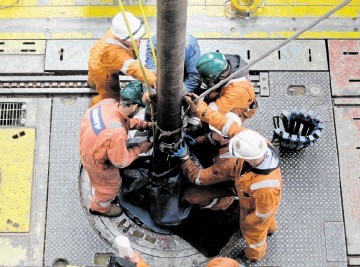
“It has been a long story,” admits Xcite Energy’s Steve Kew.
Next year will be 10 years since he and Xcite’s other co-founders set out to take on the challenge of the Bentley field. By November, it could be on the market looking for a farm-in partner and the story of the field could change dramatically.
First discovered in 1977 by Amoco and then later drilled and dropped by ConocoPhillips, it is one of the North Sea’s biggest unproduced fields with an estimated 550million barrels of oil in place – and potentially more to come.
It sits in a homogenous Paleocene Dornoch reservoir, similar to the nearby potentially smaller Bressay field, with high porosity and permeability, of about 34% and 7.5 Darcies, respectively.
However, it is heavy, at 10-12deg API, and in unconsolidated sandstone.
When he first came across it, while working for ConocoPhillips, Kew called it “grandchildrens’ oil”. However, technology is yet again playing its part in unlocking North Sea fields.
By the weekend, Xcite is due to have completed 60 days of an extended well test on Bentley, proving to lenders it is able to produce from the field using geosteering to drill 2,000ft long horizontal wells through friable reservoir, tracking its roof and proving its concept for the multiple multilateral wells it plans to drill out across the field.
But also fundamental to Bentley’s future production has been learning about water movement through the well, says Kew.
The well test, drilled from the Rowan Norway jack up rig, has involved the 9/3b-7 and 9/3b-7Z sidetrack – a lateral geosteered to track just under the roof of the reservoir. Both were drilled with water-based drilling fluids to create a gauge hole, enabling directional drilling, says Kew.
The test is utilising two electrical submersible pumps, for redundancy, pressure control management at surface to control gas content, “premium” sandscreens down hole, developed on the job, and heating systems to get the oil 180ft to the Scott Spirit shuttle tanker.
By the end of the 60 days it produced about 100,000 barrels – the first production from the field nearly five years since Xcite flowed the first oil from it.
However, it will have also produced water, deliberately.
“The most important thing is trying to understand the mobility of the reservoir,” says Kew.
“The majority of the oil (about 80%) is going to be produced through water.
“What we are really interested in is the relative permeability of the water to the oil so we can determine the long-term behaviour of the reservoir.”
The project has been no walk in the park. But it has meant the firm has learned a lot, says Kew.
As well as the work on the test, Xcite is running a research programme looking at the biology in the reservoir, to see if this could be used to its advantage to aid production with bugs in the crude create biosurfactants. It is also analysing the crude chemistry for refining and marketing purposes.
“We do not intend to give all that data away,” he says. “There are quite a lot of challenging reservoirs this data is applicable to and we want to take advantage of that.”
It has been estimated the North Sea has nine billion barrels of heavy oil in place waiting to be tapped.
“We see two billion barrels or more in the triangle between Bentley, Kraken and Bressay,” says Kew. “We see a lot of potential there. And it is a long-life production.
“There are many fields like that emerging and we have worked out how to get it out.”
However, the next stage for Xcite is production on Bentley. The firm’s stated plan has been staged production, starting with a jack-up rig and shuttle tanker, then a wellhead platform, drilled from a jack-up and connected to a moored tanker or floating production facility.
There would be about six wells designed for up to nine multilaterals each, although Kew says it would probably be more like four or five.
This would then be bridge-linked to a full facilities core area platform with gas import and potentially a third platform in the southern area of the field.
Ultimately, Kew feels the field could be bigger than Bressay and could be given the same treatment as Mariner in terms of number of wells.
Statoil has said it has a total of 145 reservoir targets for production or injection planned for Mariner, through use of multi-branch technology, sidetracks and reuse of slots on the topsides.
However, it is going to be down to money, as these things always are,” says Kew. “We would like to continue to be operator and produce it in a phased way but we are sensible in that being a small company we will not always be able to do what we want to.
“We will be putting it on the market for a farm-in around November to invite other companies to join us on the journey. We hope that could be agreed and completed by the end of 2013.
“We have submitted an environmental statement. We would like to continue the same way but if a major came along they might want to do it differently.”
Recommended for you
